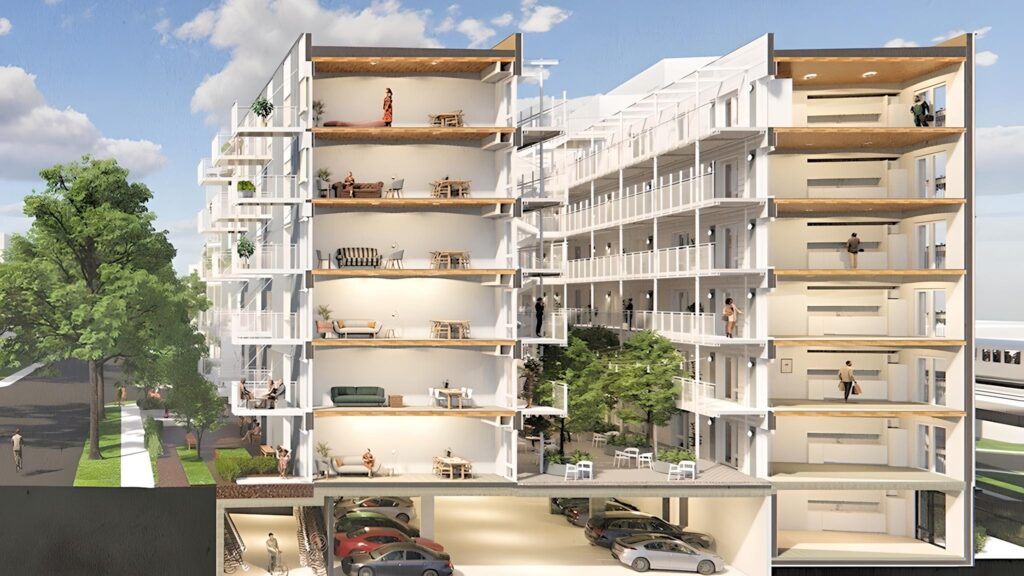Canada’s third-largest province has changed its construction code to allow British Columbia developers to build all-timber buildings up to 18 storeys – a 50% increase permitted under the old code.
It is the latest step in a push that has accelerated mass timber across British Columbia and Canada, with the Trudeau government spearheading a push to include the new code changes in the National Building Code.
The British Columbia Building and Fire Codes (BC Codes 2024), which came into effect on March 10, 2024, is part of a sweep of programs aimed at reducing embodied carbon and decarbonising construction – and comes as Canada last year became a signatory of the coalition of countries that will incentivise wooden construction to meet net-zero targets.
Until now, British Columbia only allowed mass timber buildings up to 12 storeys – higher than Australia (8 storeys), the UK (6 storeys) and New Zealand (3 storeys), with reforms bringing the province in line with the US.
According to Ravi Kahlon, British Columbia’s Minister of Housing, “the mass timber building code changes align with our recent work to deliver more homes near transit hubs by allowing taller buildings and more sustainable housing options near transit.”
Wood Central understands the changes apply to all residential, commercial and institutional buildings in the province, including Vancouver, one of Canada’s most densely populated cities, characterised by high-rise and mixed-use development.
It also coincides with the City of Vancouver expanding mass timber use in mid-rise and high-rise construction, including Vienna House, a collaboration with the City of Vienna in Austria.

“These changes will also help reduce carbon pollution, support the forestry sector, create jobs, build more homes and lead to more vibrant, healthier communities,” Minister Kahlon said in late November.
The changes will allow more exposed mass timber, or fewer layers of encapsulation in buildings, depending on the building’s height, and more building types using mass timber construction, such as schools, shopping centres, and industrial facilities.
“Mass timber is a strong, clean building technology, and with these changes, we can create astonishing buildings that display our world-class mass timber sector,” according to Brenda Bailey, Minister of Jobs, Economic Development and Innovation.
“Through our Mass Timber Action Plan, we are investing in mass timber training and finding new avenues to grow our economy while reducing our environmental impact.”
The Trudeau-led Government has identified mass timber construction systems as crucial to the future of urban development not only in the built-up areas of Vancouver, Montreal, Toronto and Calgary but nationwide, with a task group pushing to get the changes recognised in the national building code.
Wood Central understands that all provinces and territories are now considering the codes for adoption in local construction codes and future consideration in the national building codes.
Increasing the opportunities for mass timber construction comes simultaneously when British Columbia addresses the housing crisis through its Homes for People Action Plan.
In October, Wood Central reported on a push by Japanese giant Sumitomo, which uses mass timber construction systems to drive “built-to-rent” and “affordable housing projects” in North America, Europe and Asia-Pacific.
Canadian media reports that new laws will increase density in urban areas through small-scale multi-unit housing and transit-oriented development, creating more mass timber opportunities to build homes more quickly with a lower carbon footprint.
Linda Buchanan, the Mayor of the City of North Vancouver, strongly supports utilising mass timber construction systems in urban development, noting that the city “has long been a leader in leveraging mass timber technology to tackle future challenges.”
She said the changes “will allow communities to deliver more homes faster, unlock a new era of design possibilities and reduce carbon emissions.”

British Columbia is a global leader in mass timber construction technology. In June, Wood Central reported that Dr Tony Yang, a mechanical engineering professor at the University of British Columbia, was leading a study on the feasibility of 20-storey-plus mass timber construction buildings.
“The next generation of mass timber construction will mark a turning point in how we build in this country and potentially in the world,” Dr Yang said.
Dr Yang is one of the leaders of The Next Generation Wood Construction Initiative (Next-Gen), a partnership comprising 20 scientists, 12 government and commercial organisations professionals, and 31 faculty members from 14 Canadian universities, which are removing technical and non-technical barriers to wood construction.
According to Dr Yang, the main challenges include a lack of design approaches, performance data, environmental impact assessments, and more qualified people to handle the demands of rising wood consumption.
“We’re confident that with these new tools and materials under our belt, we will help Canada meet, if not surpass, its 2030 carbon emissions goals.”






